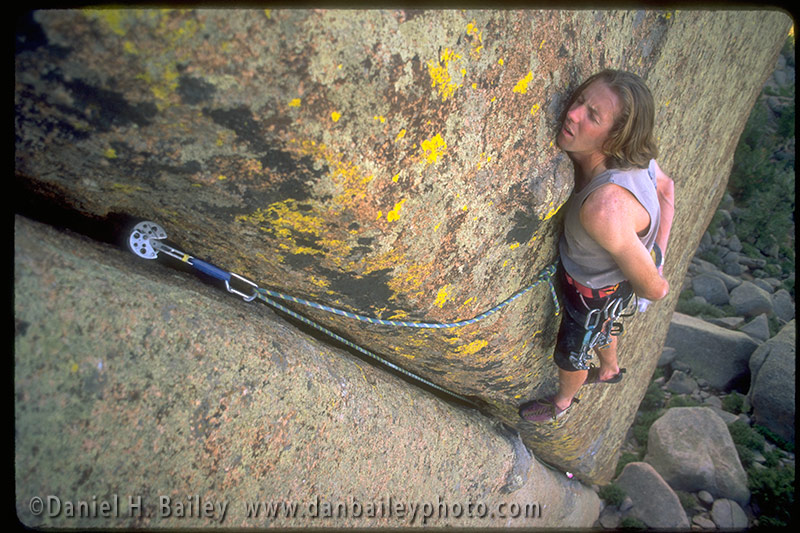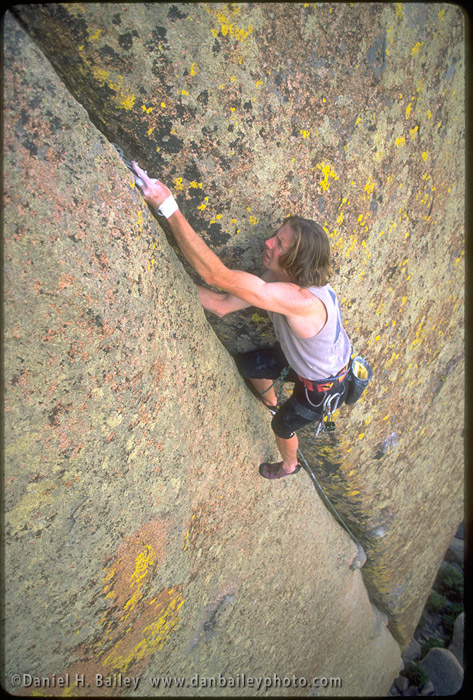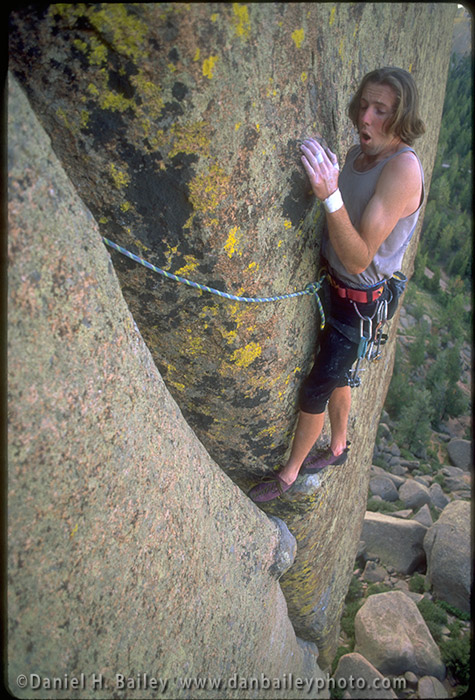Life was good in the summer of 1996. I had a pretty cush day job scanning photos at a Kodak PhotoCD lab, and I spent just about every afternoon and weekend rock climbing around Colorado and Wyoming. Still a few months away from being fired from my job… ahem, I mean turning pro, my photography passion was in full swing and I ran countless rolls of Fuji Velvia slide film through my Nikon N90 trying to build up my skills and my portfolio.
At the time I was pretty focused on rock climbing photography, and as luck would have it, I had a few built in models with my fellow dirtbag climbing buddies. One of these cats was my good friend and co-worker Curt Lyons, who sat across from me at the photo scanning station. (My other climbing co-worker was Juston Ledoux, seen bouldering in this photo.)
Tall and lanky, Curt was a southern California boy who had honed his skills at places like Joshua Tree, Tahquitz and Suicide Rocks before moving to Colorado. He was a solid climber and a lot of fun to hang out with. I learned a lot from him during those years we climbed together, and we still love to reminisce about those early days. One of my favorite memories of Curt was watching him make cowboy coffee during our trip to Devil’s Tower.
We had driven his little brown Toyota truck with the white topper up from Fort Collins the night before, and were camped in this open field within sight of the tower. The next morning, I crawled out of the back of the topper and saw Curt swinging the coffee pot around in a circle by the handle in a crazy windmill motion. He looked just like Pete Townshend.
His method was to boil a camp kettle full of water and loose coffee, then take it off the stove and use centrifugal force to make the grounds settle to the bottom of the pot. Brilliant. Pure genius, and wildly entertaining to boot.
Horn’s Mother
Anyway, during the summer of ’96, we climbed quite a bit at this funky place near Laramie called Vedauwoo. “Vee da voo,” as it’s pronounced, is like a mini Joshua Tree, full of rounded granite boulders, great crack climbing and relentless wind. The routes at Vedauwoo aren’t very long, but most of them are hard. Hard enough to make you cry. In addition to the sandbag factor of the routes themselves, the feldspar crystals that make up the surface of the rock at Vedauwoo make for great friction, but they tear your skin apart if you’re not careful. Most people tape their hands.
Of course, Curt, being a California purist, refused to ever tape up. He had good enough technique that he could get away with no tape. Me? No way. I always taped. I wasn’t nearly as confident in my skills. Plus, taping was part of the whole experience. A technique in itself. It was part of the uniform.
Sometimes during the week, Curt and I would even race up to Vedawoo to get a couple of routes in after work. Usually, we had a route in mind, and on a particular July day, we drove so that Curt could try a route called “Horn’s Mother.”
One of the classic hard routes at Vedawoo, Horn’s Mother is the highly visible 100′ overhanging, leaning, flaring fist and off width crack right on the front of the Coke Bottle formation. You can see it right from the parking lot. It’s rated at 5.11a, but that’s Vedawoo 5.11a, which means really freaking hard. I’ve led quite a few 5.11 routes in my time, but I was always way too intimidated to try Horn’s Mother.
The crux of the route is pulling through a short overhang pretty close to the start of the route. After that, you climb 25′ up to a pod, and then it’s just 50 or so feet of strenuous and sustained 5.10 hand and fists jamming up the left leaning crack. If you have small hands, it’s even harder.
Curt brought another friend to belay him so that I could shoot photos of him climbing the route. (I don’t even remember who that was, but I’m sure that Curt sill does.) We climbed an easier way up the formation so that I could fix a rappel line down the face and be right there next to him while he was on the route.
He sent the crux like is was no problem. If course, I was way above him coming down my line, so I didn’t actually see him on that part of the route. When I did meet up with Curt about halfway up the final crack, he was tired. Arms about to die tired, but he kept chugging up the crack with solid technique, a bit of brute force and the benefit of a long reach.
About two thirds of the way up, he was was getting really gassed and desperately needed a rest. Determined to do the entire route without falling or hanging on the rope, Curt knew that he had to take a break and shake his arms out, and as luck would have it, he found a way to get out of the crack and stand on these little granite pods that stuck out there on the face.
Throwing in a #4 Friend, he clipped the rope, stepped out of the crack and actually found a no-hands rest right there win the middle of one of the hardest routes that he’d ever climbed. This odd, precarious feat of balance allowed him to regain the strength necessary to power up the last section to the top.
Watching Curt climb Horn’s Mother up close was an awesome experience and I’ve always loved the photos I shot of him on the route. I’ll never forget that day and I’ll never forget the look of pain, suffering and thankful relief when he found that tiny rest spot that gave him brief reprieve from the unrelenting crack. I’ll never forget the close, intimate view that I had of him while he pushed his limits and onsighted the route on his very first try. During those brief minutes, and for the next few days, Curt was my hero.
I shot this photo on Fuji Velvia 50 slide film with my Nikon N90 and 24mm f/2.8D lens. I still have this lens, and in fact, it’s probably seen more use shooting rock climbing than any one of my other lenses.
Thanks for the memories Curt. I hope the route didn’t leave you with too many emotional scars.
My Early Years
This series called My Early Years, profiles some of my images and experiences as a budding young photographer back in the mid and late 90s. My goal to show you that photography is a progression and that we all have a long road of unique experiences that make up our photography life/career. And to tell some fun stories.
Most of the images in this series were shot on film and are thus derived from either Nikon Coolscan files or from early Kodak Photo CDs, which are still readable on Apple iPhoto.
I hope that you enjoy this look back at the much younger and much less experienced Dan Bailey. If you’d like to read more articles like this and be notified whenever I post similar features, please consider signing up for my newsletter, which also includes regular news, exclusive content, photography tips, industry isight and special deals.



